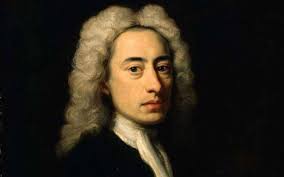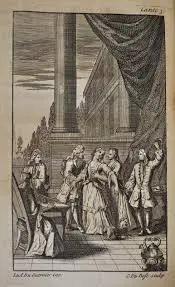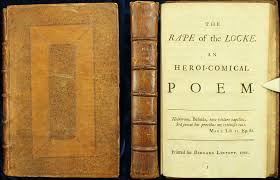The Rape of the Locke is one of the most important works of poetry of the Victorian era. Written by Alexander Pope, the poem was first published in 1712 and comprised of two cantos. In 1714, a complete five canto version of the poem was published again. The final publication of the poem was published in 1717 that included a revised version of the five cantos.
The poem is often considered one of the best mock epics of the English language and follows a real incident in which a lock of hair of a woman was cut by her suitor. As both of them belonged to the high class English society, the incident became a major issue and caused a strife between their families.
Alexander Pope, in this mock epic, has discussed the shallow nature of the high class English society by taking inspiration from that incident.

Summary of the poem and important lines
As a mock heroic epic, The Rape of the Locke is a poem that describes the trivial nature of the upper class English society. The poem has been written in an ironical tome and include a very interesting combination of the real and supernatural elements. The humans in the poem are the center of attention of the other people and supernatural beings like sylphs and nymphs.
Canto I: The poem opens with the character of Belinda, a rich and beautiful woman who wakes up late from a dream. In the dream, she is warned by her guardian sylph that something bad will happen to her. However, as she wakes up, she starts preparing herself for the day. The fist canto ends up with an elaborate description of the toilet of Belinda and her elaborate process of getting dressed to attend a gathering later in the day.
Transform ‘d to combs, the speckled and the white.
Here files of pins extend their shining rows,
Puffs, powders, patches, Bibles, billet-doux.
Now awful Beauty puts on all its arms;
Canto II: In the second canto, Belinda is ready and takes a boat for the gathering. Here, Baron, a suitor of Belinda is already present with the intention of stealing a lock of Belinda’s hair. He has been preparing for the moment since the morning. Belinda reaches and her beauty is the main attraction of the gathering. Her sylph has asked the various other nymphs to protect Belinda. Even though she has now forgotten about the dream, she has an army of supernatural beings, some guarding her clothes, some her jewelry and some her hair.
He spoke; the spirits from the sails descend;
Some, orb in orb, around the nymph extend;
Some thrid the mazy ringlets of her hair;
Some hang upon the pendants of her ear;
With beating hearts the dire event they wait,
Anxious, and trembling for the birth of fate.

Canto III: The third canto of the poem describes the gathering. While Belinda is busy playing cards and having rounds of coffee, the guardian nymphs are guarding her beauty. Baron here makes two unsuccessful attempts to steal the lock of her hair and remains unsuccessful. However, by the third attempt, the guardian sylphs get to know that Belinda wants to be violated secretly and do not stop Baron. Finally, with the help of Clarissa, he manages to cut a lock of Belinda’s hair.
And hew triumphal arches to the ground.
What wonder then, fair nymph! thy hairs should feel
The conquering force of unresisted steel?”
Canto IV: The fourth canto describes the reactions of Belinda after her lock is stolen. She is filled with rage and anger. Pope develops an apocalyptic mood here and compares the anger of Belinda with that of a king who loses a battle.
“For ever cursed be this detested day,
Which snatch’d my best, my favourite curl away.
Happy! ah ten times happy had I been,
If Hampton-Court these eyes had never seen!
Canto V: The fifth canto is filled with chaos after Belinda launches the weapons of tears and rage. Her anger is like a battle for Baron and even after a speech about good humor by Clarissa, she is not able to calm down. Finally, she demands her lock back to find that it has been lost in the chaos. To her relief, the sylph tells her that her lock has reached the heavens and has been canonized as a star.
When, after millions slain, yourself shall die;
When those fair suns shall set, as set they must,
And all those tresses shall be laid in dust,
This lock, the muse shall consecrate to fame,
And ‘midst the stars inscribe Belinda’s name.

More facts about the poem The Rape of the Locke
Characters of The Rape of the Locke: Belinda, Baron and Clarissa are the main human characters in the poem. Ariel, the guardian nymph of Belinda is a primary supernatural character.
Belinda’s toilet summary: Belinda’s toilet is full of exotic jewels and beauty products. She uses them to prepare for a gathering, but Pope describes this process as if a soldier is preparing for a war. This evokes irony from the very first canto of the poem.
Why does the Baron cut Belinda’s hair?
Like everyone else, Baron is an admirer of Belinda and her beauty. He has a number of other tokens of his affection, but he wants to finish building an alter of his love by adding a lock of her hair to it.
Character of Belinda in The Rape of the Locke: Belinda is the central character of the poem. She is represented as a beauty, which is partially because of her natural appearance and mostly because of her riches. She represents the shallowness of the society that Pope has talked about in the poem.
At the end of the poem The Rape of the Locke what happens to the lock of Belinda’s hair?
It reaches the heavens and becomes a star, immortalizing Belinda’s name for all the times to come.
Who are the sylphs?
The sylphs are the guardian angels of Belinda. These are the women who become nymphs and demi goddesses and now guide women about ways to charm eligible men with their beauty.
Read the final version of the poem here.